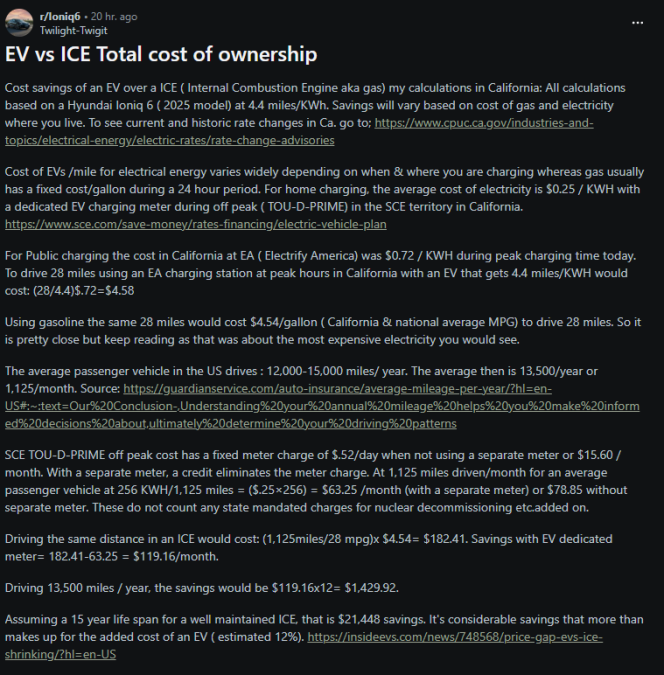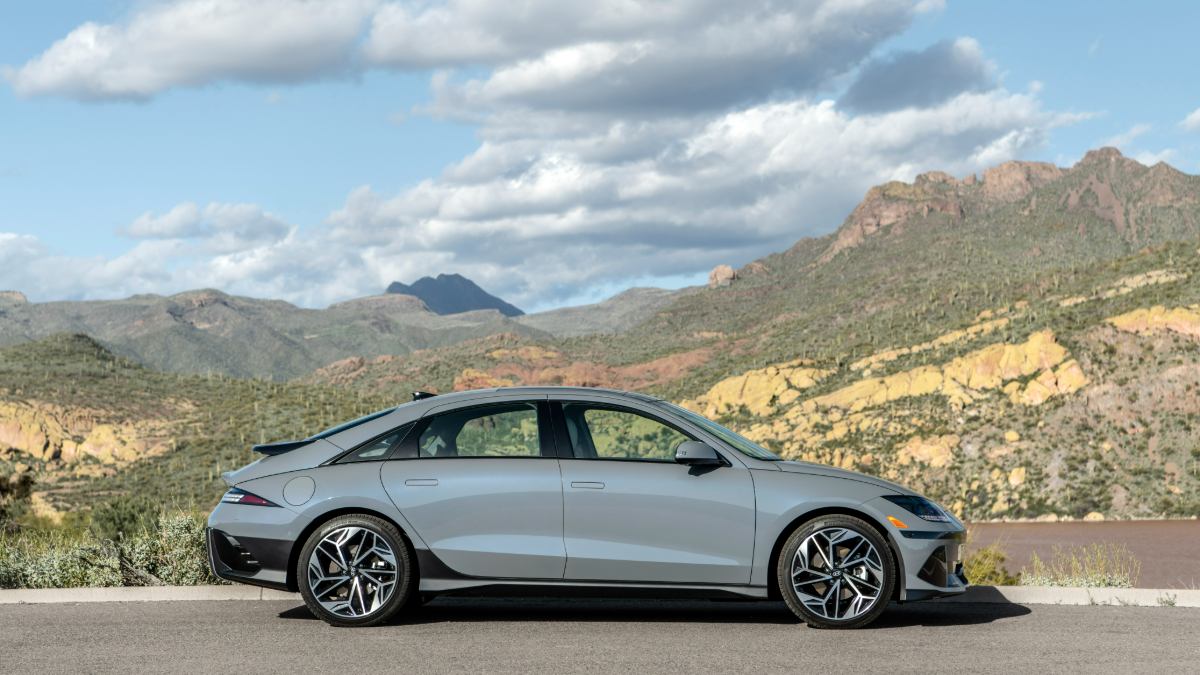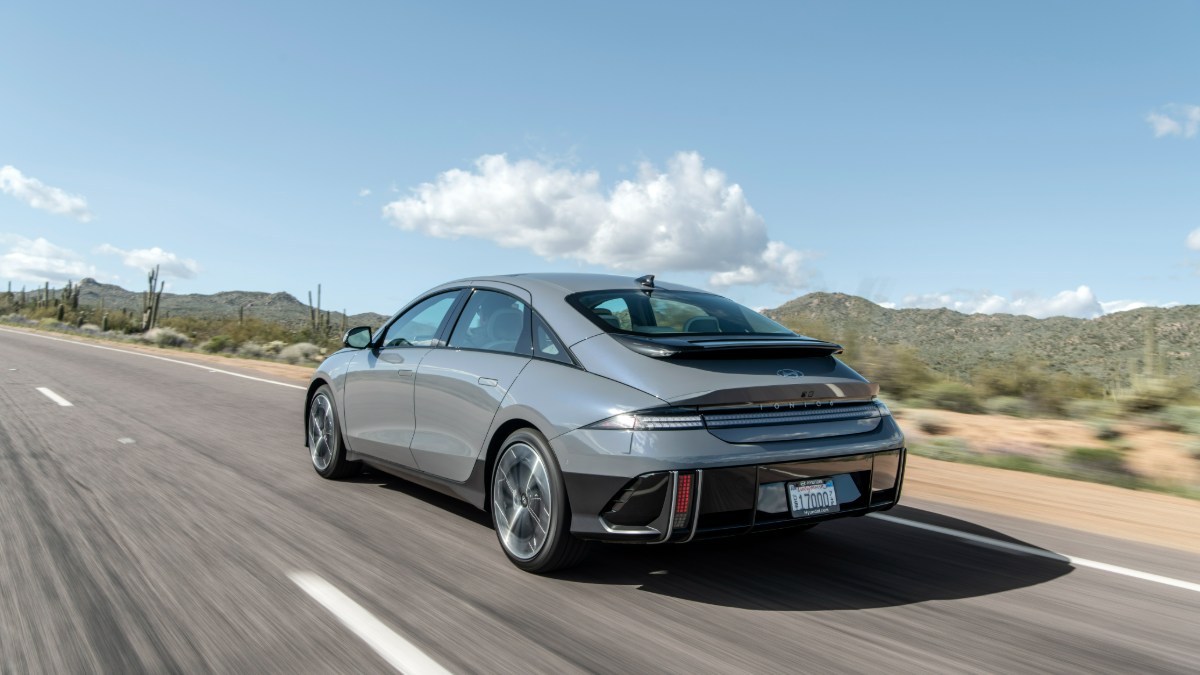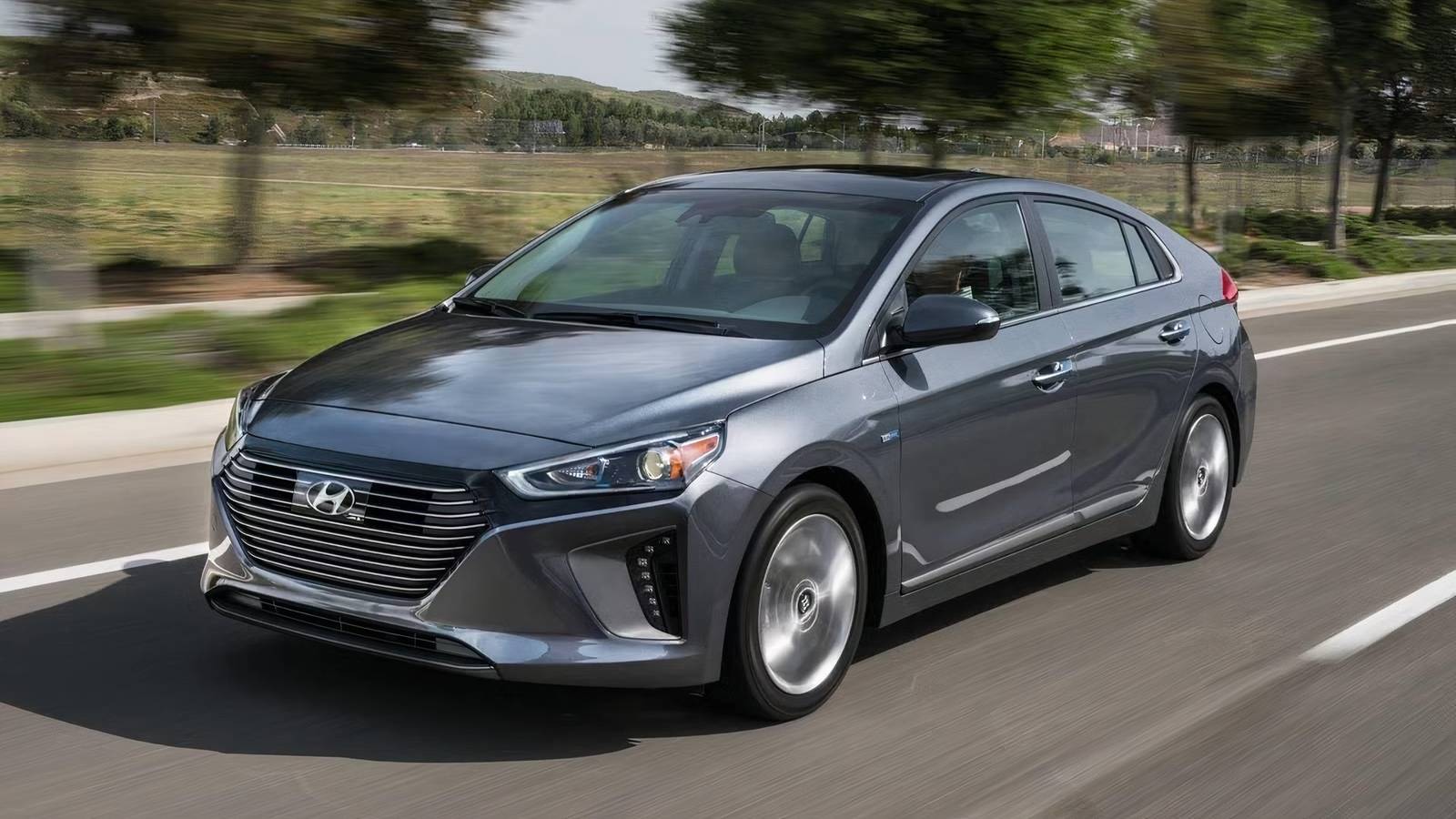
Follow us today…




The transition to electric vehicles continues to generate intense debate about the total cost of ownership, with potential buyers seeking concrete data to justify the premium pricing of electric vehicles over traditional gasoline alternatives. A detailed analysis by Twilight-Twigit provides comprehensive calculations demonstrating how the Hyundai Ioniq 6 delivers substantial long-term savings despite California’s notoriously high electricity rates, offering valuable insights for consumers evaluating electric vehicle economics across different regional markets.
The analysis focuses on the 2025 Hyundai Ioniq 6 achieving 4.4 miles per kilowatt-hour, using California’s complex time-of-use electricity pricing structure to demonstrate both the challenges and opportunities that electric vehicle owners face in high-cost energy markets. The calculations reveal how charging strategies and utility rate structures can dramatically impact the economic benefits of electric vehicle ownership, providing a framework for understanding EV economics in diverse regional contexts.
“Cost savings of an EV over an ICE ( Internal Combustion Engine, aka gas), my calculations in California: All calculations based on a Hyundai Ioniq 6 ( 2025 model) at 4.4 miles/kWh. Savings will vary based on the cost of gas and electricity where you live. To see current and historic rate changes in CA. Go to
Cost of EVs /mile for electrical energy varies widely depending on when & where you are charging, whereas gas usually has a fixed cost/gallon during a 24-hour period. For home charging, the average cost of electricity is $0.25 / KWH with a dedicated EV charging meter during off-peak ( TOU-D-PRIME) in the SCE territory in California.
For Public charging, the cost in California at EA ( Electrify America) was $0.72 / KWH during peak charging time today. To drive 28 miles using an EA charging station at peak hours in California with an EV that gets 4.4 miles/KWH would cost: (28/4.4)$.72=$4.58
Using gasoline, the same 28 miles would cost $4.54/gallon ( California & national average MPG) to drive 28 miles. So it is pretty close, but keep reading, as that was about the most expensive electricity you would see.
The average passenger vehicle in the US drives: 12,000-15,000 miles/ year. The average then is 13,500/year or 1,125/month. Source:
SCE TOU-D-PRIME off-peak cost has a fixed meter charge of $.52/day when not using a separate meter or $15.60 / month. With a separate meter, a credit eliminates the meter charge. At 1,125 miles driven/month for an average passenger vehicle at 256 KWH/1,125 miles = ($.25×256) = $63.25 /month (with a separate meter) or $78.85 without a separate meter. These do not count any state-mandated charges for nuclear decommissioning, etc, added on.
Driving the same distance in an ICE would cost: (1,125miles/28 mpg)x $4.54= $182.41. Savings with EV dedicated meter 182.41-63.25 = $119.16/month.
Driving 13,500 miles/year, the savings would be $119.16×12= $1,429.92.
Assuming a 15-year life span for a well-maintained ICE, that is $21,448 in savings. It’s considerable savings that more than make up for the added cost of an EV ( estimated 12%).
The above savings do not include the thousands of $ saved in maintenance over the life of the car.
The savings may adjust down based on miles/KWH (colder climates are less efficient), 10-30%. But the miles driven in colder weather, assuming 3 months/year, would be reduced by an average of 20% or a loss of .25/year ( .20 x 1,429.92)= a loss of $71.50 in savings/year, reducing annual savings to $1,357.42, which is still nothing to sneeze at. Note that many EVs now use LFP batteries & can lose as much as 2.5% capacity /year based on usage characteristics and climate. Range reduction does not increase cost /mile. A 340-mile range EV would lose 8.5 miles of range/year depending on the manufacturer and design. At an estimated 13,500 miles/year, a 100,000-mile warranty would run out in 7.4 years. Assuming 2.5% degradation/year x 7.4 years = 18.5% at warranty end. If the battery decreases by more than 30% during the warranty, they will replace it for free. It is unlikely you will see this degradation. Fast DC charging reportedly reduces battery capacity quickly than type 2 AC charging, but limiting it to 80% or less may buy you time.
Do your homework before buying quality & efficiency vary. Battery technology is only getting better, and degradation concerns may be mostly eliminated within the next 5 years with advancements.
EV prices will continue to come down significantly with advancements. But the longer you wait, the more savings you may lose.
Plug in your cost of gas/gallon and cost/kWh into the formulas above to determine savings where you live.
My recent display in California summer showed a 10% loss in range with AC running set to 70 degrees F on a 2025 Hyundai Ioniq 6 EV with outside temp of 96.”

This pricing structure highlights the complexity of electric vehicle economics compared to traditional gasoline vehicles, where fuel costs remain relatively stable throughout the day. The availability of dedicated EV charging meters and time-of-use rates creates opportunities for significant savings for owners who can adapt their charging habits to utility pricing schedules, though it also introduces complexity that some consumers may find challenging to navigate effectively.
Regional Electricity Costs Create Dramatic Savings Variations
The stark contrast between California’s high electricity costs and other regions becomes apparent through owner experiences that demonstrate how geographic location fundamentally impacts electric vehicle economics. Dacruze’s experience in Mississippi reveals the dramatic potential for savings when electricity costs are substantially lower than California’s rates.
Mississippi Gulf Coast here: Electricity for me is $0.04kWh on off-peak times. The average cost for fuel here is around $2.45. I drive 177 miles a day for work. 4 days a week. And then use my car on all other days for any errands or travel. That’s estimated at 35k miles for work before any additional added, each year. That’s $3100 in fuel alone.
The Mississippi owner’s experience demonstrates how high-mileage drivers in low-electricity-cost regions can achieve extraordinary savings from electric vehicle adoption. His annual driving of 35,000 miles would cost approximately $3,100 in gasoline, while the equivalent electricity consumption would cost only $410 annually, representing savings of over $2,600 per year before considering maintenance cost reductions.

This dramatic cost differential illustrates how electric vehicles can be particularly attractive for high-mileage drivers in regions with low electricity costs, creating compelling economic arguments for fleet operators, delivery services, and commuters with long daily drives. The combination of high annual mileage and low electricity costs creates a scenario where electric vehicle adoption can pay for itself within just a few years through fuel savings alone.
The maintenance savings compound these fuel cost advantages significantly. Not to mention the $90 every 7-10 weeks for an oil change. (Was 7500 miles per oil change, then hit higher mileage. So every 5000 miles for an oil change. Plus, the recommended maintenance for my warranty. I spent nearly $1700 in a year in maintenance just for oil changes and the 65k+ mileage maintenance. These maintenance costs, which disappear with electric vehicle ownership, add another $1,700 in annual savings, bringing the total annual benefit to over $4,300 for this high-mileage driver.
Public Charging Economics Challenge Road Trip Viability
The analysis reveals concerning disparities between home charging economics and public charging costs that could impact electric vehicle adoption for drivers without reliable home charging access. The comparison between home and public charging costs demonstrates how charging infrastructure pricing can undermine the economic benefits of electric vehicle ownership for certain use cases.
For Public charging, the cost in California at EA (Electrify America) was $0.72 per KWH during peak charging time today. To drive 28 miles using an EA charging station at peak hours in California with an EV that gets 4.4 miles/KWH would cost: (28/4.4)$.72=$4.58. Using gasoline, the same 28 miles would cost $4.54/gallon (California & national average MPG) to drive 28 miles.
This near-parity between public charging costs and gasoline expenses reveals a critical challenge for electric vehicle adoption among drivers who cannot charge at home or who frequently rely on public charging infrastructure. The economic benefits of electric vehicles largely disappear when drivers must rely primarily on expensive public charging networks, particularly during peak pricing periods.

SnooShortcuts4021’s experience with California’s complex electricity pricing structure further illustrates the challenges facing EV owners in high-cost regions. Yeah, in SoCal I’m paying ~.62 on peak and .32 off peak plus delivery rates. California electricity is bonkers. EA charges .68-84 for their chargers, so it saves on those, but without solar, we’re getting rammed on electricity. The observation about solar power suggests that renewable energy generation may be necessary to achieve meaningful savings in high-electricity-cost markets, adding complexity and upfront investment requirements for optimal EV economics.
The pricing disparity between regions becomes even more apparent when comparing public charging costs. Dacruze notes that using charging stations isn’t a viable option anywhere due to the price. I could understand if the cost to charge from 20-80% was the price of filling a gas tank the same amount, but it’s like 3x the cost if not more (my experience). This observation highlights how public charging pricing strategies may be undermining electric vehicle adoption by eliminating the fuel cost advantages that make EVs attractive to consumers.
EV Cost Analysis Key Findings:
- Electricity costs vary dramatically by region, with Mississippi’s $0.04/kWh off-peak rates creating annual savings of over $2,600 compared to California’s $0.25/kWh rates for similar driving patterns.
- Drivers covering 35,000+ miles annually can achieve extraordinary savings through reduced fuel and maintenance costs, with total annual savings exceeding $4,300 in low-electricity-cost regions.
- Peak-time public charging costs approach gasoline parity, eliminating fuel cost advantages and potentially making EVs less economical for drivers without reliable home charging access.
- Traditional maintenance expenses, including oil changes and transmission service, disappear with EV ownership, adding $1,700+ in annual savings for high-mileage drivers.
Tire Costs and Design Challenges Impact Long-Term Economics
The discussion reveals how electric vehicle-specific design choices can create unexpected ownership costs that partially offset fuel and maintenance savings. SnooSketches5568’s experience with tire-related expenses demonstrates how EV-specific features can create new categories of ownership costs that buyers may not anticipate.
With the EV, you will save on maintenance (oil change/transmission-related/brakes), but you will pay more for tires. During the first 15k miles on my Ioniq6, tire-related expenses were 3x the electricity costs. I had a tire puncture in the acoustic foam that they refused to patch. And a pothole flat requiring 4 new tires from wear differences.
The acoustic foam technology designed to reduce road noise creates repair challenges that can force complete tire replacement for minor punctures that would be easily repairable on conventional tires. This design choice, while improving the driving experience, introduces new ownership costs that can significantly impact the economic benefits of electric vehicle ownership, particularly for drivers in areas with poor road conditions or high debris exposure.
The owner’s solution reveals how informed consumers can mitigate these design-related costs through strategic modifications.
I changed to 18″s and it’s gotten much better than the 20″s. Changing to 4 new 18″ rims and tires was cheaper than 4 new 20″ OEM tires. I have more tire selection, they last 60k miles vs 20-30k, they can go over a pothole without having to call a flatbed tow truck, and if I drive over a nail I can save $450 with a free patch.
This modification strategy demonstrates how electric vehicle owners can optimize their ownership costs by making informed choices about wheel and tire configurations. The switch from 20-inch to 18-inch wheels not only reduces replacement costs but also improves durability and repairability while extending tire life from 20-30k miles to 60k miles, fundamentally changing the long-term cost equation.
Dacruze’s analysis of tire costs over the vehicle’s lifetime provides perspective on how these expenses fit into the broader economic picture. If you had to replace your tires 6 times over the average lifespan of a vehicle (200k miles). That’s $1400 per set. At a total cost of $8400. While an ICE replaces its sets on an average of 4 times over 200k miles. At around $1000 per set. With a total cost of $4000. Even accounting for higher tire costs, the maintenance savings from eliminating oil changes and other traditional services more than offset the additional tire expenses.
Long-Term Ownership Cost Considerations:
- EV-specific tire technologies like acoustic foam can prevent simple puncture repairs, forcing expensive tire replacement for minor damage that would cost under $50 to repair on conventional tires.
- Larger wheels increase replacement costs and reduce durability, with 20-inch wheels costing significantly more than 18-inch alternatives while providing shorter service life and reduced repairability.
- EV tire life varies dramatically based on driving habits and wheel size choices, with reports ranging from 18,000 to 60,000 miles depending on configuration and usage patterns.
- Despite higher tire costs, the elimination of traditional maintenance expenses creates net savings, with annual tire cost increases of approximately $260 offset by maintenance savings exceeding $1,700 annually.
Long-Term Savings Projections Validate EV Economics
The comprehensive analysis demonstrates how electric vehicles can deliver substantial long-term savings despite higher upfront costs and some increased ownership expenses. The 15-year savings projection of over $21,000 provides compelling evidence for the economic viability of electric vehicle ownership, particularly for drivers who can optimize their charging strategies and maintenance approaches.
Driving 13,500 miles per year, the savings would be $119.16×12= $1,429.92. Assuming a 15-year life span for a well-maintained ICE, that is $21,448 in savings. It’s considerable savings that more than make up for the added cost of an EV (estimated 12%). These projections account for the current price premium of electric vehicles while demonstrating how operational savings can overcome initial cost disadvantages over typical vehicle ownership periods..
The forward-looking perspective on technology improvements suggests that current economic advantages will likely improve over time. Battery technology is only getting better, and degradation concerns may be mostly eliminated within the next 5 years with advancements. EV prices will continue to come down significantly with advancements. But the longer you wait, the more savings you may lose. This observation highlights the tension between waiting for better technology and missing current savings opportunities, providing guidance for consumers considering the timing of their electric vehicle adoption.
The comprehensive cost analysis reveals how electric vehicles can provide substantial long-term economic benefits despite regional variations in electricity costs and some increased ownership expenses. The key to maximizing these benefits lies in understanding local utility rate structures, optimizing charging strategies, and making informed choices about vehicle configuration and maintenance approaches.
For high-mileage drivers in low-electricity-cost regions, the economic case for electric vehicles is overwhelming, with annual savings potentially exceeding $4,000 when fuel and maintenance cost reductions are combined. Even in high-cost regions like California, strategic charging and the elimination of traditional maintenance expenses create meaningful long-term savings that justify the initial price premium of electric vehicles.
The analysis demonstrates that while public charging costs can eliminate fuel cost advantages, home charging combined with time-of-use rates and dedicated EV meters can provide substantial ongoing savings. The key insight is that electric vehicle economics are highly dependent on individual usage patterns, regional infrastructure, and charging strategies, requiring potential buyers to carefully evaluate their specific circumstances rather than relying on generalized assumptions about EV ownership costs.
As charging infrastructure continues to expand and battery technology continues to improve, the economic advantages of electric vehicles will likely become more pronounced across a broader range of use cases and geographic regions. The ongoing development of more efficient EV technologies and improved charging infrastructure will further enhance the value proposition for consumers considering the transition to electric mobility.
The comprehensive nature of this analysis provides a valuable framework for consumers evaluating electric vehicle adoption, demonstrating how detailed cost modeling can reveal the true economic impact of transitioning from traditional gasoline vehicles to electric alternatives. The regional variations and individual usage patterns highlighted in the discussion underscore the importance of personalized analysis rather than relying on broad generalizations about electric vehicle economics.
Have you calculated the total cost of ownership for an electric vehicle in your region? What factors have been most important in your EV economics analysis, and how do your local electricity rates and driving patterns compare to the examples discussed? Share your own cost analysis experiences and regional insights in the comments below.
Image Sources: Hyundai Media Center
Noah Washington is an automotive journalist based in Atlanta, Georgia. He enjoys covering the latest news in the automotive industry and conducting reviews on the latest cars. He has been in the automotive industry since 15 years old and has been featured in prominent automotive news sites. You can reach him on X and LinkedIn for tips and to follow his automotive coverage.
Follow us today…




link







